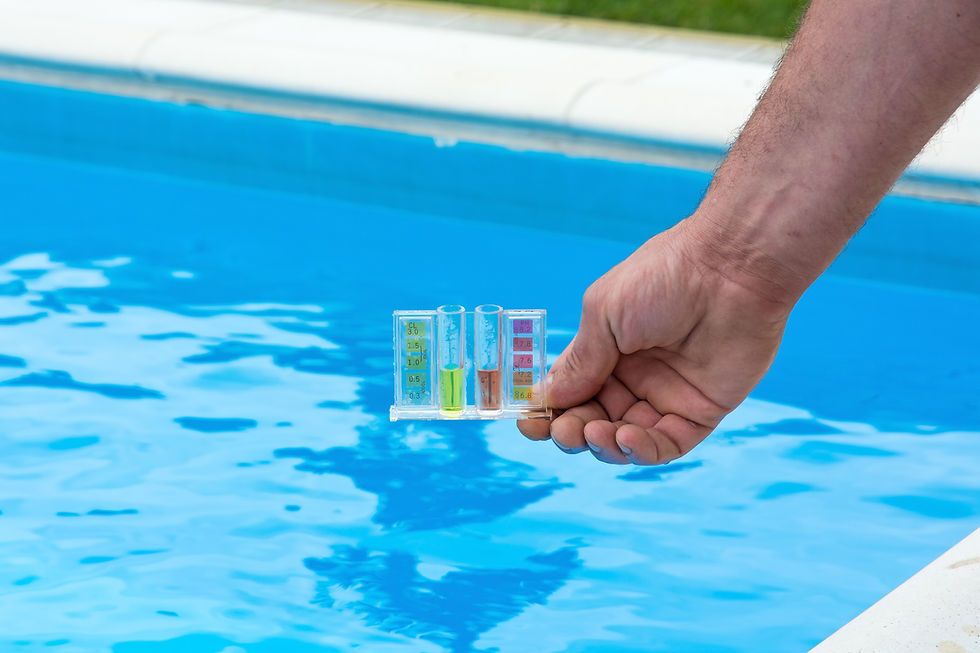HOW DO I CLEAN MY POOL AFTER IT RAINS?
- Phillip Malone
- Nov 7, 2016
- 3 min read
CLEANING YOUR SWIMMING POOL AFTER IT RAINS
While we rejoice about all the recent rain we've been getting here is Sacramento, it can wreak havoc on your swimming pool or spa. If you aren't fortunate enough to have a pool or spa cover, we've got some tips to help you keep your pool looking its best, even through the stormy season.
Fall and winter storms brings acidic rain and contaminating debris. With a little elbow grease and the proper dosing of chemicals, you can keep your swimming pool from turning green during the rainy season. Even though this time of year is not ideal for swimming, it is important to maintain your pool properly year round to avoid irreversible damage and expensive repairs. Read below for proper steps to take when cleaning a swimming pool after it rains.
STEPS FOR CLEANING A POOL AFTER IT RAINS
The first issue you will want to address after a storm, is the removal of debris from your swimming pool. Begin by emptying all skimmer baskets then, use a net to skim and remove floating leaves, sticks and other debris from the surface of your pool. Next you will want to use a pool vacuum to remove the debris that has sunk to the bottom. A pool vacuum can be purchased from your local pool store, online or at some home improvement stores. A pool vacuum differs from an automatic pool cleaner or pool sweep as it used manually and can remove larger debris that automatic pool cleaners can not pick up. After you have removed all of the surface and sunken debris from your pool, use a brush attachment to brush the walls of your pool. Make sure to brush the tile line and any stairs, swimouts or ledges.

Once the swimming pool is cleared of all debris, it is time to test and dose your pool's water chemistry. First, check the pH of your swimming pool's water, ideal pH level of swimming pool water is 7.5, but is still safe between 7.2 and 7.8. Rain is acidic in nature, therefore after a storm it can cause your swimming pool's pH level to decrease. Next, check the alkalinity levels. The alkalinity in your pool helps maintain the pH, consequently, these levels may be decreased more drastically than the pH alone. Finally, check the chlorine/sanitizer levels in the pool water. Extra water from rain and contamination from debris can deplete the chlorine levels in your swimming pool. And on the subject of extra water, before dosing your pool with any chemicals, make sure you drain any excess water if the water level is too high. The water level should be halfway up your pool skimmer inlet. Once your swimming pool's water level is drained back to normal, you may proceed with dosing your pool with any necessary chlorine, sanitizer and/or alkalinity (sodium bicarbonate) to balance the water chemistry.
SHOULD I SHOCK MY POOL AFTER A STORM?
Many pool owners ask if it is necessary to shock a swimming pool after a rain storm. The answer is no, it is not necessary, but maintaining proper chlorine levels is. Chlorine levels should be between 2 and 4 parts per million. If your pool has started to turn green, you can use an algaecide to address any algae blooms. Make sure you follow the above steps to clean your pool, drain to an appropriate water level and then follow the steps on the algaecide packaging as algaecides differ from brand to type.
FINAL NOTES ON CLEANING A POOL AFTER IT RAINS
We hope this article helps you knowledgeably address your pool after the rain storms we've been getting hit with recently. If there is just light rain, most of these steps won't be necessary and a routine cleaning will suffice. If you do not want to deal with the mess after a storm, Apex Pool Service of Sacramento is here to help. We offer one time cleanings, as well as weekly pool cleaning services from West Sacramento to Roseville and Elk Grove to Rancho Cordova. We are experts in maintaining swimming pools and spas and take great pride in our work. Call for a free on site estimate today 916-248-9161










Comments